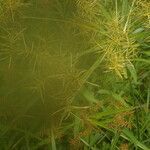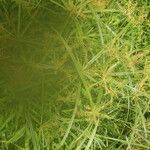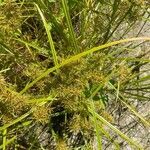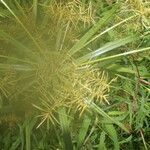Annual with fibrous roots (perennial under favourable circumstances?). Stems usually stout, solitary or 2-3 together, trigonous, triquetrous in the upper part, smooth, 20-100 cm by up to 6 mm, leafy up to 30 cm above the incrassate base. Leaves subcoriaceous, flat, shortly acuminate, scabrid on the margins, up to 12 mm wide. Inflorescence compound or decompound, rather loose to dense, 5-25 cm across. Involucral bracts 6-8, spreading, the larger ones far overtopping the inflorescence, up to 50 cm. Primary rays 7-12, obliquely patent, smooth, up to 20 cm; cladoprophylls usually with a short leafy blade. Spikes ovoid to oblong, 1½-3 cm wide; rachis narrowly winged, with 20-30(-60) spikelets. Spikelets spicately arranged, horizontally spreading to reflexed, subterete, linear, somewhat flexuous, 4-20-flowered, 5-25 by 1-1½ mm, when mature breaking up into segments each containing 1 nut; rachilla flexuous, broadly winged; wings elliptic, at first hyaline, finally much thickened, corky, tightly clasping the nut; internodes 1-1½ mm. Glumes rigid, chartaceous, at first appressed, finally with patulous top, broadly ovate or elliptic, obtuse, muticous or minutely apiculate, rounded on the back, rather distant, up to ⅓ imbricate (rarely the tip not reaching the base of the next glume above), with green, 5-9-nerved back, yellowish, reddish brown striate sides, and hyaline margins, 2-3½ mm long. Stamens 3; anthers oblong-linear, ½-1 mm. Stigmas 3. Nut falling off with an internode of the rachilla and the next higher glume, held by the persistent wings, trigonous, oblong, or narrowly obovoid, slightly excurved, apiculate, greyish brown to blackish, 1½-2 by ½-¾ mm.
More
Stout annual 1–8 dm; lvs 2–10 mm wide; bracts several, mostly surpassing the infl and some much elongate; rays (0–)3–10, 2–10 cm, branched at the top, producing a congested infl; prophylls prolonged 5–15 mm beyond the orifice into a bilobed tip; spikelets linear-cylindric, brownish at maturity, 1–2 cm, 5–20-fld, divaricately spreading; scales ovate, (1.5–)2–3 mm, finely several-nerved, obtuse or acute; rachilla articulate at the base of each scale, at maturity readily separating into joints, its internodes outwardly arcuate, conspicuously winged, the wings enfolding the achene; achenes brown, trigonously oblong or obovoid-oblong, 1–2 mm. Moist or wet soil; pantrop., n. to Mass., se. Me., Ont., Minn., and Kans. (C. engelmannii; C. ferax; C. ferruginescens; C. speciosus)
A herb or sedge. It can grow each year from seed or keep growing from year to year. It has rhizomes. It grows 20-80 cm tall.











